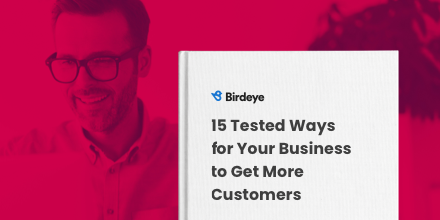The difference between securing a new client and losing them to the competition can often hinge on the strength of your business proposal. This tool has the power to demonstrate your ability to meet the unique needs of potential clients, but it requires careful preparation. In order to create a winning proposal, you must first thoroughly understand the client’s needs, research the industry, and develop a strategic approach that showcases your expertise and ability to deliver results.
In this blog post, we’ll explore the components of a winning business proposal and offer tips and strategies to help you craft a proposal that effectively attracts clients and establishes long-lasting partnerships.
Table of contents
- Understanding the basics of a business proposal
- How to create a business proposal: The preparation
- Researching the client and their needs
- Defining project objectives and goals
- Analyzing the competition
- Developing a clear value proposition
- Structuring the proposal
- Crafting a compelling executive summary
- Describing the company and its expertise
- Presenting the scope of work, methodology, and deliverables
- Outlining a realistic timeline and pricing options
- Including testimonials and references
- Proofreading and editing
- Submitting and following up on the business proposal
- Business proposal formats and sample templates
- FAQs about a business proposal
- Final takeaways of a business proposal
Understanding the basics of a business proposal
If you want to understand how to make a business proposal, there are a few basics to cover.
What is a business proposal?
A business proposal is a document that presents a potential solution to a client’s problem or need. It typically includes a summary of the proposed solution, an explanation of the value it would provide to the client, and a breakdown of the cost and timeline associated with implementing the solution. A business proposal is often used to secure new clients or partnerships, and it can serve as a key tool in the sales process.
Why is a business proposal important?
It’s rare for companies to work together after only a handshake or giving their word. A business proposal is important because it provides a clear understanding of what the client can expect from the company.
The business proposal establishes a clear scope of work, including timelines, deliverables, and costs, ensuring that both the company and the client have a shared understanding of what will be delivered and when. Additionally, the process of creating a business proposal allows the company to gather feedback from the client, which can be used to refine the proposal and further tailor the solution to the client’s specific needs.
Types of business proposals
The following are the various types of business proposal formats:
- Solicited proposals: A solicited proposal is created in response to a request for proposal (RFP) from a client. The RFP outlines the client’s specific needs and requirements, and the proposal must address these requirements.
- Unsolicited proposals: An unsolicited proposal is created without a specific request from a client. This type of proposal is often used to pitch a new product or service to a potential client.
- Internal proposals: An internal proposal is created for an internal audience, such as management or employees. It may be used to propose a new project or initiative within the company.
- Sales proposals: A sales proposal is created to persuade a potential customer to purchase a product or service. It must outline the benefits of the product or service and explain how it meets the customer’s specific needs.
- Partnership proposals: A partnership proposal is created to propose a strategic partnership between two companies. It must outline the benefits of the partnership and how it aligns with the goals of both companies.
- Grant proposals: A grant proposal is a business proposal example of what is created to secure funding for a specific project or program. It must show the project’s value and how it aligns with the grantor’s objectives.
- Investment proposals: An investment proposal aims to attract investors who are interested in financing a project or venture. It must include a clear business vision, market analysis, financial details as well as a competitive analysis.
As you can see, each type of business proposal requires a unique approach and may include different elements depending on the audience and purpose of the proposal.
How to make a business proposal: The key elements to include
The following are the key elements that should be included in a business proposal outline:
- Executive summary: This section should provide a brief overview of the proposal, highlighting the key points and goals of the project.
- Problem statement: This section should describe the problem or opportunity the proposed project aims to address.
- Objectives: This section should clearly state the objectives of the project, including specific, measurable, achievable, relevant, and time-bound (SMART) goals.
- Methodology: This section should outline the methodology that will be used to achieve the project’s objectives, including the activities and resources required.
- Timelines: This section should provide a detailed timeline of the project, including the start and end dates for each phase and major milestone.
- Budget: This section should detail the costs associated with the project, including labor, materials, and other expenses, as well as how the funds will be allocated.
- Deliverables: This section should clearly specify the deliverables that will be provided upon completion of the project, including any reports, data, or products.
- Risk analysis: This section should identify the potential risks and challenges associated with the project, as well as strategies to mitigate them.
- Evaluation: This section should outline how the project’s success will be evaluated, including the metrics and criteria that will be used.
- Conclusion: This section should summarize the main points of the proposal and provide a compelling argument for why the proposed project should be supported.
How a business proposal and a business plan differ
The difference between a business plan and a business proposal is that a business plan is a comprehensive document that outlines the overall strategy, goals, and operations of a business. In contrast, a business proposal is a focused document that outlines a specific project or idea and aims to persuade external stakeholders to support it.
A business plan is typically used internally by the business owners and management team, while a business proposal is targeted to external stakeholders such as potential clients, partners, or investors.
How to create a business proposal: The preparation
Before writing a proposal, think about your brand, the client’s needs, and expectations, and how your company’s skills, products, or services meet their needs. The proposal needs to be organized, easy to read, and convincing to the client, demonstrating you can successfully solve a problem or complete a job. Preparing to write a business proposal involves several critical steps that can make the difference between a persuasive and effective proposal and one that falls short. Here are the key steps:
Researching the client and their needs
Get an edge on the competition, whether responding to an RFP or reaching out to an unsolicited client. Conduct thorough research on the client and their industry to understand their needs, pain points, and requirements for the project. Know everything about the client, what they need most, and how they can benefit from your value, products, or services.
Defining project objectives and goals
Clarify the objectives and goals of the project, including what the client wants to achieve and how the proposal can help them do so.
Analyzing the competition
Identify the competition and understand its strengths and weaknesses to differentiate the bid proposal from other potential bidders. Focus on what you do better than others in your industry, and share any certifications, education, experience, or customer testimonials that back up your claims.
Look for any weak points with the competition where they fail to deliver and fill in these gaps for a prospective client.
Developing a clear value proposition
Clearly communicate the unique value that the proposal brings to the table and how it will help the client achieve their objectives.
Once you have completed these steps, you’re ready for this next section, where we provide a template on how to write a proposal.
Structuring the proposal
The business proposal should have a clear structure that includes an introduction, a body, and a conclusion. The body should be organized into sections that cover the key aspects of the proposal, such as the scope of work, methodology, and pricing.
Crafting a compelling executive summary
The executive summary is the opener of the business proposal, it gives a brief overview of the proposal that highlights its key points and benefits. It should be clear, concise, and persuasive and entice the reader to read the rest of the proposal.
Describing the company and its expertise
This part of the proposal should include information on the company’s history, experience, qualifications, and any relevant awards or certifications. Here’s where to share company “wins,” describe how your brand is better than competitors, and highlight unique attributes. Sell your company’s ability to deliver to the client and how the client will benefit from working with your brand.
Presenting the scope of work, methodology, and deliverables
After a client learns more about who you are and your expertise, show you can handle a project with finesse. The client must know and trust that you have superior planning and execution skills and a reliable method to deliver what you promise.
This section should outline the specific services or solutions that the proposal offers, the methodology that will be used to deliver them, and the expected deliverables. It should be detailed enough to give the client a clear understanding of what they will receive but not so detailed that it becomes overwhelming.
Outlining a realistic timeline and pricing options
The proposal should include a timeline that outlines the key milestones and deadlines for the project. It should also include pricing options that are clear, transparent, and competitive.
Including testimonials and references
People trust word-of-mouth referrals. Testimonials and references can be a powerful way to build trust and credibility with the client. The proposal should include quotes from satisfied clients, as well as references that the client can contact for more information.
Proofreading and editing
After compiling the different sections in a business proposal, wait a moment before sending it. Carefully take your time to proofread and edit this document. This includes checking for typos, grammatical errors, and formatting issues, as well as ensuring that the proposal is clear, concise, and persuasive. Don’t skip this crucial step.
Submitting and following up on the business proposal
Tips for submitting the proposal to the client
Make sure to follow any specific submission guidelines provided by the client, such as format, file size, and deadline. Address the proposal to the specific person who will be reviewing it, and use a professional tone in all communications. A cover letter should be included that briefly summarizes the proposal and expresses gratitude for the opportunity to submit it. Also, you should provide the client with multiple ways to contact you, such as email, phone, and website, so they can reach you easily if they have questions.
Strategies for following up with the client
Give the client the agreed-upon amount of time to review the proposal before following up. Then, send a polite email or make a phone call to ask if the client has any questions or needs additional information.
Remind the client of the key benefits outlined in the proposal and how your solution can help them achieve their goals.
Handling proposal acceptance or rejection
Whether the proposal is accepted or rejected, respond promptly to the client to show that you value their time and input. If the client says “Yes,” be ready to move from the proposal stage to actualizing the project.
Sometimes, a client isn’t a good match, and they say “No.” It may not be the right time, there could be budget constraints, or the proposal fails to deliver on client expectations. If the proposal is rejected, ask for feedback on why it wasn’t accepted and how you can improve for future proposals.
Whether the proposal is accepted or rejected, maintain a positive relationship with the client to potentially work together in the future.
If you are looking for business proposal templates, look no further. We have a free template you can download and customize for your own use. Or, you can use any of the templates in the next section geared towards a specialty.
[Free] Business Proposal Template
Download Now
Business proposal formats and sample templates
Check out these quality business proposal examples for various business functions for inspiration.
Sales proposal template
This business proposal sample of a sales proposal template covers the project scope, pricing, and details for prospective clients.
Digital marketing proposal template
Highlight your expertise in digital media and content creation with this digital marketing proposal template.
Marketing consulting proposal template
Show how you can solve your prospective client’s problems with this marketing consulting proposal template. Review different marketing proposal templates that fit the digital world or in-person clients.
SEO proposal template
Choose an SEO proposal template that includes the benefits of optimizing the prospective client’s website, SEO basics, your approach, an implementation timeline, deliverables, price estimates, and collaboration terms.
Market research proposal template
Show clients you can accomplish what they need with a market research proposal template that delivers.
Event management proposal template
Use this event management proposal template to show your expertise in creating memorable connections at events.
Roofing proposal template
Get right to business with this roofing work proposal template for clients that need a contractor.
FAQs about a business proposal
A good proposal is well-structured, personalized to the client’s needs, and effectively communicates a solution to the client’s needs and objectives. It should include a detailed scope of work, methodology, pricing, and timelines.
A business proposal should start with an executive summary that provides a brief overview of the proposal’s key points and benefits. The executive summary should grab the reader’s attention, highlight the key benefits of the proposed solution, and emphasize why the proposal is the best choice for the client.
The length of a business proposal typically ranges from 5 to 25 pages depending on the complexity of the project, the client’s requirements, and the level of detail needed to communicate the proposal effectively.
The difference between a proposal and an estimate is that a proposal outlines a proposed solution to a problem. An estimate provides a rough approximation of the costs involved in a project or service.
A good proposal should be long enough to provide all the necessary information but short enough to maintain the reader’s interest and attention, generally ranging between 5 and 25 pages, with the most effective proposals falling between 10 and 15 pages.
In a business proposal, it’s important to avoid jargon and technical language. Use relevant content, avoid overpromising, present the proposal in a well-formatted and visually appealing manner, and thoroughly proofread and edit the proposal.
A business plan is a long-term document that outlines a company’s strategy, goals, and objectives, while a business proposal is a shorter document that presents a specific solution to a particular problem or needs that a client has identified.
Final takeaways of a business proposal
Writing a winning business proposal requires careful planning, research, and attention to detail. By following the steps outlined in this guide, you can create a proposal that clearly outlines your proposed solution, demonstrates your expertise and value proposition, and persuades the client to move forward with the project. Remember to focus on the client’s needs, avoid common mistakes, and tailor your proposal to the specific opportunity. With these tips in mind, you can increase your chances of success and win more business with your proposals.

Originally published









